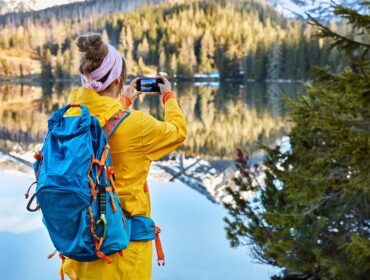Maps are incredible tools. They guide us across continents, down winding highways, through national parks and hidden valleys. With a simple touch of the screen, GPS can point us to the nearest summit or safest trailhead. But not every journey is made for the map. Some paths can’t be pinned by coordinates or planned on an app. They live deep inside us – unmarked, unpredictable, and profoundly personal. They lead us to the road within.
These are the inner journeys – the moments of self-discovery, growth, reflection, and revelation that happen not because we got somewhere, but because we went somewhere. They often happen in the quiet corners of the world where external noise fades and internal dialogue begins. In nature’s raw presence, far from schedules and notifications, we often stumble into something far more powerful than a destination: a transformation.
This is a tribute to those off-map journeys. The ones that unfold under the stars, through solitude, or with a heavy pack on your back and no clear plan ahead. Let’s explore why these uncharted adventures matter – and how they often end up guiding us more than any map ever could.
1. The Wilderness Is a Mirror

Step into the wild – really step in – and the world changes. There’s no one to impress, no mirrors, no performance. What’s left is you. The wilderness strips away layers: the job title, the social feed, the to-do list. In its place, nature holds up a mirror, showing us who we are when no one’s watching.
This reflection can be unsettling at first. Silence forces us to hear our own thoughts. Slowness challenges our fast-paced minds. But with time, this discomfort turns to clarity. We start to recognize our fears, our longings, our resilience. It’s not the trail that changes us—it’s what we confront while walking it.
2. Lost and Found

One of the most common phrases among seasoned hikers is: “I got lost, but I found something better.” Sometimes, getting lost is the point. It forces us to reorient not just geographically, but emotionally. When the path disappears – when fog rolls in or the markers fade – we tap into instinct, creativity, and intuition.
These moments of uncertainty remind us that life doesn’t come with complete directions. That learning how to trust ourselves, to pivot and adapt, is often more valuable than following a perfect plan. In getting physically lost, we often find emotional grounding.
3. Slowing Down to Catch Up

Modern life moves at a relentless pace. Even our vacations can feel like to-do lists. But some journeys – especially the inward ones – require slowness. Walking a forest trail without cell service. Sitting by a river until the sun dips low. Watching embers burn out in silence. These pauses become the real milestones.
Slowness gives us space to process. To let emotions surface. To reconnect with thoughts and ideas buried beneath routines. Out in nature, we catch up with ourselves – not just where we’re going, but where we’ve been.
4. Solitude as Teacher

Many people fear solitude, but the trail teaches us to embrace it. There’s a difference between being alone and being lonely. Solitude is full of presence. It sharpens awareness, opens emotional doors, and fosters independence. Some of the most profound internal shifts happen when we’re alone in a place that feels vast and alive.
Solo hikers often report moments of unexpected peace or inspiration – a sudden answer to a life question, an emotional release, or a surge of confidence. The absence of noise allows the inner voice to finally be heard.
5. The Power of Discomfort

Nature doesn’t cater to comfort. There are blisters, unpredictable weather, cold mornings, and sore muscles. But discomfort breeds growth. When you’re 10 miles in and the rain starts falling, you learn how strong you are. When you carry a heavy pack up a steep incline, you build more than muscle – you build perseverance.
These challenges shift your perspective. What once seemed like a big problem – emails, missed calls, minor stresses – suddenly shrink in comparison to simply keeping warm or reaching the next shelter. The internal journey here is one of resilience and recalibration.
6. Nature as Therapist

Science backs what many adventurers already know – nature heals. Studies show that time in the outdoors reduces stress, anxiety, and symptoms of depression. But beyond those metrics, nature offers something deeper: a space to feel.
In the mountains, on a lonely ridge or beside a still lake, we’re given permission to feel joy, grief, awe, confusion – all without judgment. The world expands and so do we. It becomes easier to process emotional wounds, make sense of loss, or gain clarity about decisions leading the road within.
7. Unseen Destinations

When you set off for a hike, you may think your goal is the summit or the overlook. But many times, the true destination is invisible. It’s a shift in mindset. A new way of seeing. A release of something long carried.
You return from these trips with stories, yes – but also with a stronger sense of self. You may not have snapped the perfect photo or even followed your intended route, but you gained something more enduring: insight, peace, or perspective.
8. Shared Silence, Deep Bonds

While solo journeys are powerful, group experiences can also lead to inward transformation – especially when silence is allowed. There’s something sacred about hiking side by side with someone for hours without talking, letting the rhythm of footfalls and nature’s sounds do the speaking.
These shared silences build intimacy. When conversations do arise around the campfire or during rest breaks, they’re often more honest and open. The journey becomes both a shared memory and a mirror held up by those who walk beside you.
9. Letting Go of the Itinerary

Some of the best inner journeys happen when we let go of plans. When rain changes the route or a hidden trail calls us to explore. By surrendering to what is, we tap into presence.
Life is rarely linear, and neither are the best journeys. The road within doesn’t follow a GPS route. It loops, detours, doubles back. It’s okay not to know where you’re headed. Often, the not-knowing is what makes it worthwhile.
10. Bringing the Trail Home

The greatest journeys don’t end at the trailhead – they ripple into our daily lives. The clarity you found on the mountain? It helps you navigate relationships. The confidence earned on a stormy night? It shows up at work. The patience practiced over miles? It softens your everyday stress.
The road within may begin outdoors, but it doesn’t stop there. You bring it back in how you move through the world – with more calm, more clarity, and more courage.
Final Thoughts: The Path You Can’t Plot
Maps are useful – but not all roads worth taking appear on them. Some paths are internal, winding through fears, dreams, revelations, and healing. They are taken step by step, often unknowingly, until you look back and realize how far you’ve come – not geographically, but personally through the road within.
So the next time you pack your backpack and lace your boots, know that the real journey might not be on the trailhead sign. It might be somewhere inside you – waiting for quiet, for stillness, for space to unfold.
And that journey? That’s the one that stays with you forever.
FAQs: The Road Within
Q1: How do I prepare for an inner journey while outdoors?
Leave distractions behind. Hike solo or in silence. Bring a journal. Embrace stillness.
Q2: What’s the best type of trail for reflection?
Choose quieter, less-traveled trails with natural beauty – lakes, forests, ridgelines, or valleys.
Q3: Can I experience the “road within” on short hikes?
Absolutely. Even a one-hour walk in nature can offer deep insight if approached with intention.
Q4: What gear supports this kind of journey?
Comfortable hiking shoes, weather-appropriate layers, hydration gear, and a journal or sketchbook.
Q5: How do I reflect after the journey?
Write it down. Share it with a trusted friend. Or simply sit with what you felt and learned.





